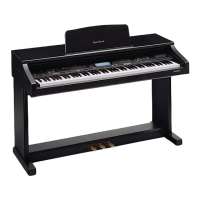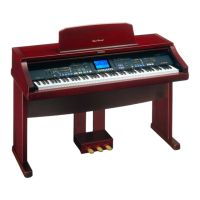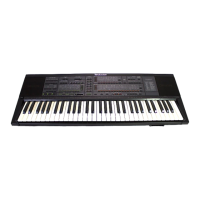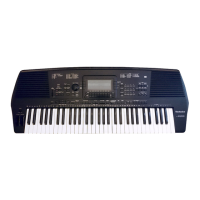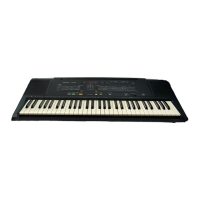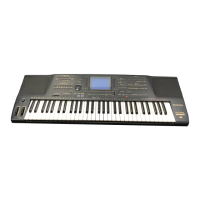
Do you have a question about the Technics SX-PR305 K and is the answer not in the manual?
| Type | Digital Piano |
|---|---|
| Number of Keys | 88 |
| Polyphony | 64 notes |
| Sound Generation | PCM |
| Effects | Reverb, Chorus |
| Speakers | Yes |
| Headphone Jack | Yes |
| Demo Songs | Yes |
| Metronome | Yes |
| Transpose | Yes |
| Tuning | Yes |
| Power Supply | AC Adapter |
| Touch Sensitivity | Yes |
| Connectivity | MIDI In/Out |
| Key Action | Weighted Hammer Action |
| Recorder | 2-Track Recorder |
Overview of fundamental operations and instrument features.
Detailed explanations of sound, effects, and performance features.
Guide for sound and rhythm selection details.
Choose standard piano or various performance styles.
Select preset automatic rhythm patterns.
Listen to programmed demonstration tunes.
Automatic sound and effect selection for rhythms.
Instrument pitch can be adjusted for compatibility.
Shows performance info, settings, and messages.
Store and recall panel settings instantly.
Use the instrument as a standard piano.
Choose from four distinct piano sound types.
Apply a reverberation effect for spaciousness.
Enhance sound richness and performance.
Change the tempo using the dial.
Start performance with an introduction.
Switch to a flashier rhythm pattern.
Insert fill-in patterns during rhythm playback.
Finish performance with an ending pattern.
Information shown during normal performance.
Accessing functions via menu buttons.
Shows available options when setting functions.
Navigate through menu sections or pages.
Return to the previous display.
Maintain the current display during performance.
Adjust settings using the dial.
Adjust the display contrast for readability.
Access explanations for instrument functions.
Use the instrument as a standard piano.
Divide keyboard into two sections with different sounds.
Play with automatic accompaniment by specifying chords.
Activate piano mode and select piano sounds.
Choose sounds from various instrument groups.
Details for sustain, sostenuto, and soft pedals.
Create percussion performances using keyboard keys.
Enhances sound richness and performance.
Applies a reverberation effect to the sound.
Play two different sounds simultaneously.
Adjust the volume balance between mixed sounds.
Specify a split point at any key location.
Adjust volumes for left and right keyboard parts.
Change the instrument's key in semitone steps.
Choose a rhythm from available groups and lists.
Use the metronome for practice or timing.
Play selected rhythm using START/STOP button.
Start rhythm by pressing a keyboard key.
Adjust rhythm volume using BALANCE controls.
Set tempo using the TEMPO/PROGRAM dial.
Begin performance with an intro pattern.
Start performance with a one-measure count.
Add drama by switching to a flashier rhythm pattern.
Insert fill-in patterns during rhythm performance.
Finish rhythm performance with an ending pattern.
Plays accompaniment matching selected rhythm and chords.
Specify chords by root note or full chord.
Specify chords using root note and simple combinations.
Specify chords by playing all notes for complex recognition.
Chord recognition for unrecognized chords.
Use entire keyboard for chords, adding accompaniment to piano.
Adjust volumes of Auto Play Chord parts.
Turn accompaniment parts on/off to alter sound.
Changes accompaniment patterns based on performance.
Quickly set sounds, effects, and rhythms for immediate play.
Tips for professional introductions and custom registrations.
Set panel settings according to selected music style.
Tips for using registrations as a starting point.
Store and instantly recall panel settings.
Define settings stored in Panel Memory (Normal/Expand).
Using factory settings and custom registrations.
Key capabilities like tempo change, consistent sound, editing.
Introduction to Easy Record, Realtime Record, Step Record.
Available memory for storing notes and performances.
Accessing functions like Easy Record, Edit, Play.
Quick recording without complex setup procedures.
Adjust playback settings.
Erase or modify recorded performance data.
Correct selected portions of performance without re-recording.
Assign parts to specific track numbers.
Play songs from a disk continuously.
Steps for setting up and recording a performance.
Steps for playing back recorded Easy Record data.
Record performance with exact timing as played.
Play back recorded realtime performances.
Adjust part and track volumes during recording.
Play back selected tracks from realtime recording.
Record chord progressions and panel settings for Auto Play Chord.
Modify or erase recorded chord progression data.
Play back stored chords with Auto Play Chord accompaniment.
Record changes in rhythm, intro, fill-in, and ending patterns.
Modify or erase recorded rhythm progression data.
Assign sequencer parts to track numbers.
Choose edit operations like Song Clear or Track Clear.
Erase all recorded contents from all tracks.
Erase contents of a specific track.
Correct timing inaccuracies in recorded performance.
Combine contents of two tracks into a third track.
Erase specific measures or data types.
Copy measures from one track to another.
Enter and exit recording mode manually during playback.
Set punch-in/out points beforehand for automatic recording.
Details on parts that form accompaniment patterns.
Available memory for storing notes and patterns.
Create new rhythms by modifying existing ones.
Compose entirely new rhythm patterns from scratch.
Set time signature and number of measures for patterns.
Assign a name to a recorded rhythm pattern.
Specify key and chord for pattern creation.
Define phrase progression styles for bass and accompaniment.
Steps to record each part of a rhythm pattern.
Information shown on screen during pattern recording.
Limitation on notes sounding simultaneously per part.
Select bank and rhythm to play back patterns.
Controls for playback like START/STOP and tempo.
Select Composer mode (Normal or Expand).
Create and record custom intro, fill-in, and ending patterns.
Storage capacity and expansion options.
Play commercial song disks in Standard MIDI File format.
Format for exchanging musical data between devices.
Identifies key components like disk slot and indicators.
General steps for using disk drive functions.
Recall data from disk into instrument memory.
Save instrument data to a disk.
Load Standard MIDI File data into sequencer.
Save sequencer data in Standard MIDI File format.
Load specific composer data from disk.
Format new disks or erase recorded disk contents.
Steps to load data from disk into instrument memory.
Steps to load Standard MIDI File data into the sequencer.
Load specific composer data into memory.
Prepare new disks or erase existing data.
Save instrument data to disk, including file naming.
Erase songs from a disk.
Set PR Header and One Measure Space for MIDI files.
Erase MIDI files from a disk.
Adjust tuning, touch response, and other parameters.
Adjust sound attributes for each part.
Assign different functions to pedals.
Fine-tune the instrument's pitch.
Select between standard and equal-interval tuning.
Adjust keyboard touch response sensitivity.
Control sound generation for soft key presses.
Select instrument sound for each keyboard part.
Shift the pitch of parts up or down.
Adjust stereo balance for each part.
Enable or disable digital reverb for individual parts.
Set pitch range for MIDI pitch bend data.
Adjust the volume for each part.
Select reverb type and depth.
Choose desired harmony style for Techni-Chord.
Select Auto Play Chord advanced mode type.
Assign functions to sostenuto and soft pedals.
Explanation of MIDI IN, OUT, and THRU terminals.
Illustrates connecting instruments and computers via MIDI.
How performance data is sent using MIDI channels.
Kinds of MIDI data: note, program change, control change.
MIDI standard for data exchange between different equipment.
Establish optimum settings for MIDI connections.
Assign MIDI channels to each part.
Shift pitch of transmitted sound by octaves.
Specify compatibility with General MIDI instruments.
Specify if sound is generated when MIDI data is transmitted.
Enable/disable start/stop data and select clock mode.
Set common functions for all parts.
Configure how performance data is treated during transmission.
Specify how panel memory affects program change data.
Control sound generation when transmitting MIDI data.
Manage start/stop data and clock modes.
Set common functions applicable to all parts.
Configure handling of performance data transmission/reception.
Enable/disable transmission of drum part data.
Enable/disable transmission of Auto Play Chord data.
Specify note number data exchange with transpose active.
Enable/disable recall of MIDI settings when loading disk data.
Specify how program change numbers are interpreted.
Enable/disable exchange of song number data.
Return settings and memories to factory-preset status.
Details on temporary memory retention after power off.
Default settings applied when the instrument is turned on.
Connect to other MIDI instruments.
Connect the included pedal.
Connect external sound sources like rhythm machines.
Connect to amplifiers for high-volume output.
For silent practice with headphones.
Connect a microphone for playing along.
